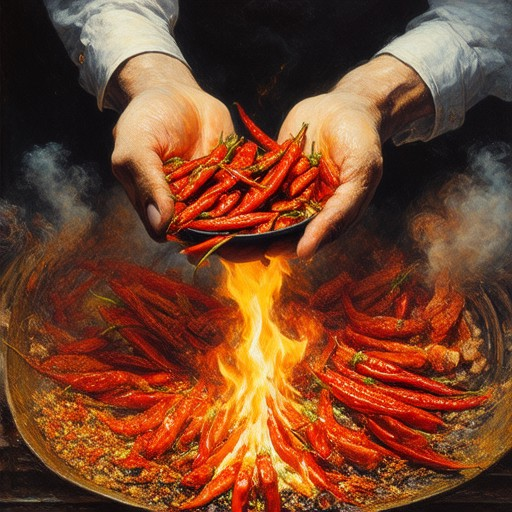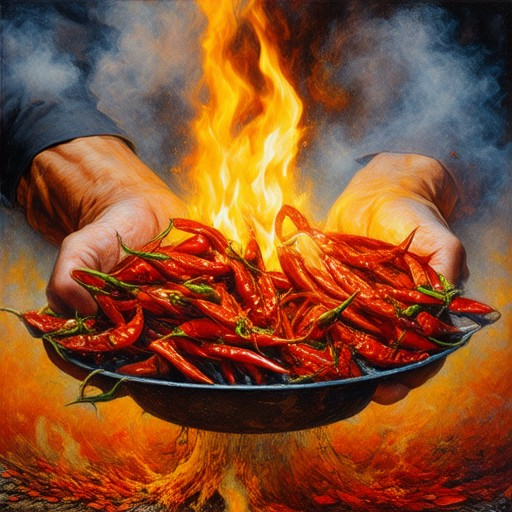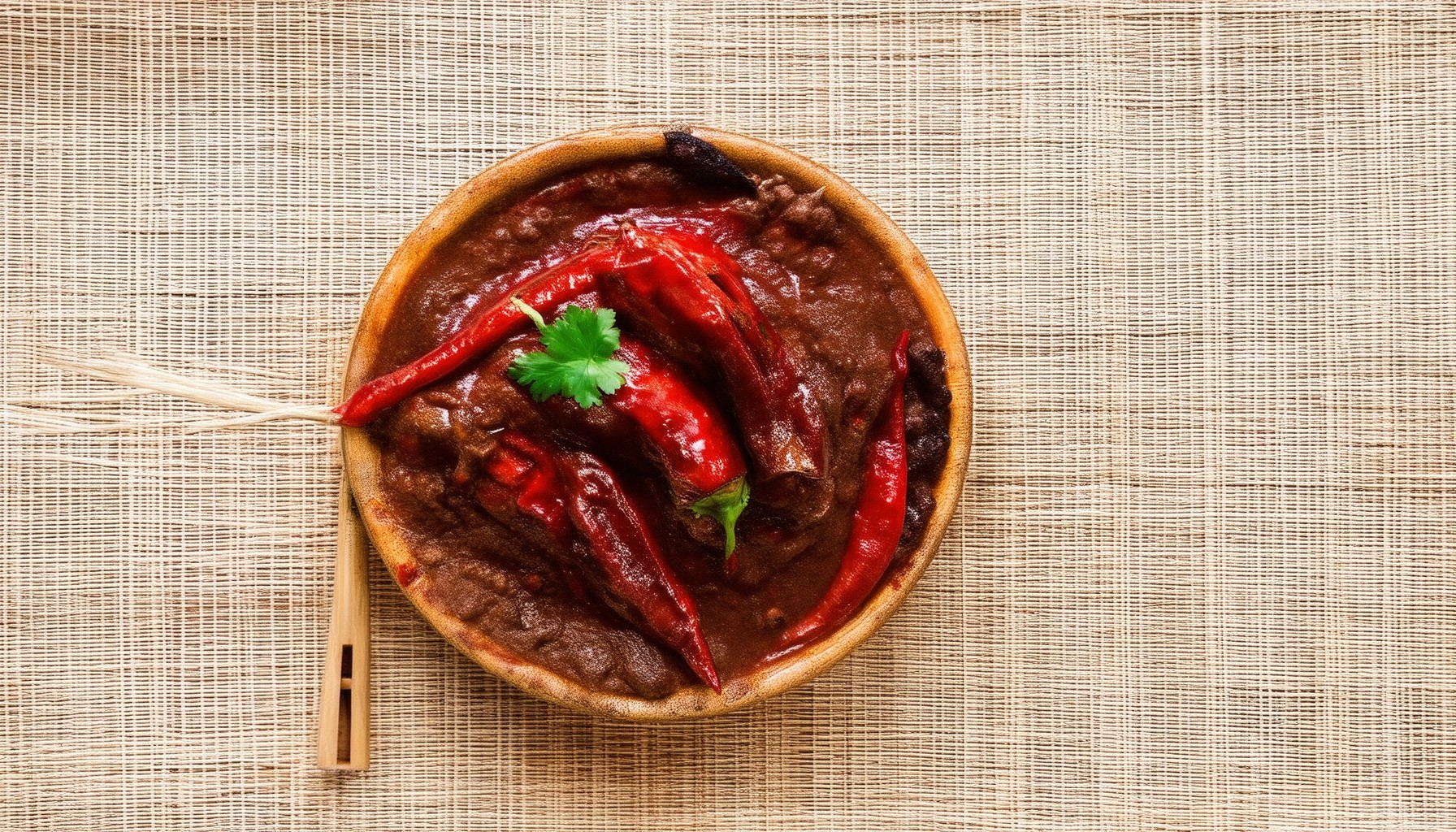Delight your senses with the rich, complex flavors of authentic Mexican cuisine as you uncover the art of crafting the perfect mole with roasted chiles. Renowned for its deep umami notes and smoky aroma, mole is a dish that transcends mere meals, embodying the vibrant culture and culinary traditions of Mexico. Whether you’re a seasoned chef or a cooking enthusiast, this guide offers an insider perspective on mastering the beloved dish, exploring everything from the types of chiles that give mole its distinctive character to the subtle nuances that elevate your recipe to unparalleled heights. From the rich history of mole Poblano to the unique twist of Oaxacan variations, discover how roasted chiles are the cornerstone of this iconic dish. With expert tips, step-by-step instructions, and a deep dive into the ingredients that make mole truly special, this comprehensive guide ensures you’ll achieve perfection every time. Dive in and embark on a journey to understand why mole with roasted chiles remains a cherished tradition across generations.
Key Takeaways
– Discover the rich history and unique flavor of Mole Negro, a cornerstone of authentic Mexican cuisine.
– Understand the key ingredients and traditional methods behind crafting Mole Negro.
– Explore the variety of mole recipes, from chocolate-laden options to spice-forward variations.
– Dive into why Mole Poblano reigns as Mexico’s most beloved mole, known for its versatility and cultural significance.

Types of Chiles Used in Mole
Mole, a beloved dish in Mexican cuisine, typically features a complex blend of spices, herbs, and chiles. The choice of chiles significantly impacts the flavor, heat level, and overall complexity of the sauce. Here are some common types of chiles used in mole:
- Ancho Chiles
- Dried and smoked, ancho chiles add a rich, earthy flavor to mole. Their moderate heat makes them a versatile choice for balancing other ingredients.
-
Chipotle Peppers
- Chipotle peppers, also dried, offer a smoky undertone and moderate heat. They are often rehydrated before use to enhance their texture and flavor.
-
Mulato Chiles
- Known for their dark color and fruitiness, mulato chiles bring a unique sweetness to mole. Their deeper flavor complements other spices well.
-
Guajillo Peppers
- Bright red in color, guajillo peppers are known for their vibrant flavor and medium heat. They are a staple in many mole recipes.
-
Chile Negro (Black Chiles)
- These chiles are large and have a deep, almost black color. They add a bold flavor and significant heat to mole, contributing to its intensity.
By using a combination of these chiles, mole achieves a nuanced balance of flavors, heat levels, and textures. Experimenting with different varieties can elevate your mole to new heights, offering a richer and more complex dining experience. For more insights into crafting the perfect mole, visit our Panito Mole resource library.
What is the difference between mole and mole poblano?
Mole and mole poblano are both iconic sauces in Mexican cuisine, but they have distinct characteristics and uses. Here’s a breakdown of their differences:
- Mole: A general term referring to a rich, complex sauce or marinade used in various cuisines, particularly Mexican. Traditionally, mole is made with a base of chocolate, chili peppers, tomatoes, onions, garlic, and a variety of spices. It can be spicy, sweet, or savory depending on the ingredients.
- Mole Poblano: A specific type of mole originating from Puebla, Mexico. It is considered one of the most authentic and complex forms of mole. Mole Poblano typically includes ingredients like pasilla chilies, almonds, raisins, capers, and sometimes eggs. It is known for its deep flavor and is often served with dishes like carnitas or turkey in mole sauce.
Key differences:- Ingredients: Mole Poblano includes specific ingredients like pasilla chilies and nuts, making it richer and more complex.- Flavor: Mole Poblano has a sweeter, earthier taste due to the inclusion of fruits and nuts, while traditional mole can vary widely in flavor based on regional variations.- Usage: Mole is a versatile sauce used in many dishes, whereas mole poblano is often associated with specific dishes like carnitas or turkey in mole.
Both sauces are essential in Mexican cuisine, offering rich and flavorful additions to a variety of meals.

What is the difference between mole poblano and Oaxaca?
Mole poblano and mole Oaxaca are two distinct types of mole sauces, each with unique characteristics and origins. Here’s a breakdown of their differences:
- Ingredients: Mole poblano typically consists of a base of chocolate, tomatoes, onions, and spices, often flavored with nuts, seeds, and dried fruits. It is considered simpler in preparation. Mole Oaxaca, on the other hand, is known for its complexity and rich texture. It includes ingredients like dried fruits, nuts, seeds, and a variety of spices, creating a multi-layered flavor profile.
- Preparation: Mole poblano is traditionally prepared with a simple simmering method, resulting in a smooth and rich sauce. It is often served with meats like chicken or pork. Mole Oaxaca involves a more intricate preparation process, often involving roasting and grinding ingredients to achieve a thick, velvety texture. It pairs well with dishes like carnitas or grilled meats.
- Origin: Mole poblano originates from Puebla, Mexico, where it is known for its simplicity and popularity in local cuisine. Mole Oaxaca traces its roots to Oaxaca, Mexico, where it is associated with the region’s rich culinary traditions and sophisticated dishes.

What is the Black Mole in Mexican Food?
The black mole, or mole negro , is a distinctive and complex sauce originating from the state of Oaxaca in Mexico. Known for its deep, rich color and bold flavor, it is one of the most celebrated components of Mexican cuisine, particularly in dishes like Panito Mole .
Origin and History
The black mole traces its roots to pre-Columbian times, with indigenous tribes using smoked chiles and seeds to create flavorful sauces. Over centuries, this tradition evolved, blending Spanish influences with local ingredients to become the iconic mole negro we know today.
Key Ingredients
At the heart of mole negro are the chilhuacles negros , small, smoky dried chiles that give the sauce its dark color and intense flavor. These chiles are charred, then rehydrated to soften their texture and enhance their taste. Other essential ingredients include:- tomatoes – onions – garlic – cumin – cloves – ancho chiles – seeds (such as sesame or sunflower)
How It’s Made
To prepare mole negro, chefs typically: 1. Char the chilhuacles negros to caramelize their sugars, then soak them to rehydrate and mellow their flavor. 2. Combine the charred chiles with a base of tomatoes and onions, sautéed until smooth. 3. Add spices like cumin and cloves to infuse the sauce with aromatic complexity. 4. Simmer the mixture for hours to allow the flavors to meld together, achieving a thick, velvety consistency.
Uses and Serving Suggestions
Black mole is a versatile ingredient that can elevate a variety of dishes, from traditional pan dulce (Mexican sweet bread) to modern fusion dishes. It’s often served as a dipping sauce or drizzled over desserts and appetizers.
Final Thoughts
The black mole is more than just a sauce—it’s a cultural icon representing the rich history and culinary ingenuity of Oaxaca. At Panito Mole, we take pride in preserving these traditions while experimenting with innovative ways to integrate mole negro into our recipes, ensuring each creation reflects the depth and complexity of authentic Mexican flavors.
Explore our Mole Negro recipe to experience this legendary dish for yourself!
Does All Mole Have Chocolate?
Mole, a beloved dish in Mexican cuisine, typically features chocolate as a key ingredient, particularly in the Oaxacan variants. However, not all mole recipes include chocolate. While the classic Mole Poblano and Mole Oaxaca often incorporate chocolate for depth and richness, some traditional recipes may omit it, relying instead on other spices and ingredients. The presence of chocolate varies depending on the region and the specific preparation method.
Here’s a breakdown of mole types and their common ingredients:
- Mole Poblano : A popular choice in central Mexico, this recipe often includes chocolate, giving it a slightly sweeter taste.
- Mole Oaxaca : Traditionally made in Oaxaca, this version frequently incorporates chocolate for its signature flavor profile.
- Vegetarian Mole : Some vegetarian versions substitute chocolate with other ingredients like mushrooms or seeds, though this is less common.
- Traditional Mole : In some regional recipes, chocolate is optional, allowing for variations in flavor.
For those looking to explore mole-making at home, Panito Mole offers detailed guides and recipes to help you create authentic mole dishes, whether you prefer the chocolate-laced versions or traditional spice-forward recipes. Check out our mole recipe collection for inspiration.
Learn how to make mole with our step-by-step guide, perfect for both beginners and experienced cooks.

What is the most popular mole in Mexico?
Mole poblano is widely regarded as the most popular and iconic type of mole in Mexico. Originating from the state of Puebla, this rich, complex sauce has earned the title of Mexico’s national dish. Its versatility makes it a favorite choice for many Mexicans, often served with dishes like chicken, pork, or turkey.
Here’s why mole poblano stands out:
- Complex Flavor Profile : Mole poblano combines a blend of spices, chocolate, tomatoes, onions, garlic, and various herbs to create a deep, earthy flavor. The addition of chocolate gives it a unique richness that sets it apart from other mole varieties.
- Cultural Significance : With roots tracing back to pre-Columbian times, mole has evolved into a symbol of Mexican identity. Mole poblano, in particular, is celebrated for its ability to bring people together around the table.
- Versatility : Mole poblano can be prepared in varying degrees of heat, catering to different preferences. From mild to spicy, it adapts to individual tastes, making it suitable for a wide range of dishes.
While mole poblano reigns supreme, other regional variations like Oaxacan mole and Veracruz-style mole also hold significant prominence. Each variation reflects the unique culinary traditions of its origin, showcasing Mexico’s diverse gastronomic heritage.
For those looking to explore authentic mole recipes and learn how to prepare this beloved dish, Panito Mole offers a wealth of resources and expertise. Their platform is dedicated to celebrating the art of traditional Mexican flavors, including the preparation of mole sauces and other culinary delights.
In conclusion, mole poblano’s widespread popularity and cultural significance make it a cornerstone of Mexican cuisine, enjoyed by millions across the country and beyond.





0 Comments